
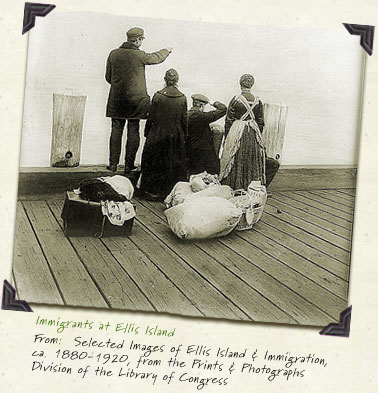
These immigrants, pictured at Ellis Island, faced an uncertain future. They may have come to America to find new opportunities or to avoid problems in their homeland.
Some of these new Americans came to Iowa. They built farms or worked in one of the many Iowa industries that processed farm products or manufactured farming equipment.

There were many reasons that caused immigrants to come to America. Some came to find work. Others came to buy land. Still others wanted to avoid religious persecution.
This picture raises many questions about immigration to America:
Directions:

Immigrants left their homes and came to the 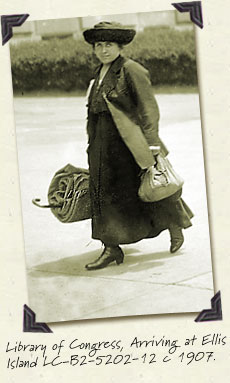 United States for many reasons. They left because of economic, religious and political factors. Some came to avoid war, corrupt governments or religious persecution. Still others came because they couldn’t find work in their own country. From as early as 1620 when the Pilgrims arrived at Plymouth Rock, America was seen as the land of freedom and opportunity.
United States for many reasons. They left because of economic, religious and political factors. Some came to avoid war, corrupt governments or religious persecution. Still others came because they couldn’t find work in their own country. From as early as 1620 when the Pilgrims arrived at Plymouth Rock, America was seen as the land of freedom and opportunity.
In Europe, the Pilgrims were persecuted for their religious beliefs. They came to America to find religious freedom.
Economic opportunities also drew people to America. As the country grew and developed, immigrants could find jobs and the opportunity to own their own land.
The number of people immigrating to the United States was not constant during every period of American’s history. As the chart indicates, immigration grew rapidly between 1870 and 1900.
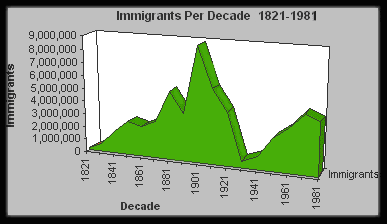
During this time, most immigrants came from Europe but some came from Asia as well. Most Asian immigrants were from China but a small number also came from Korea and Japan.
It was during this time that technology was developing rapidly as well. Larger and faster steam ships brought people to America by the thousands. Railroads grew and expanded allowing people to travel quickly and efficiently. Factories were built to produce the many new products that were invented at this time.
The following list includes just a few of the inventions that were developed between 1876 and 1900:
|
|
The rise of American industry and the growth of the railroad system created thousands of jobs both in factories and in the construction trades.
For immigrants some factors pushed them from their country while other factors pulled them toward America.
Complete this chart by identifying the correct push and pull factors.

After 1892, Immigrants who came to America from Europe and other countries came through Ellis Island. Sometimes thousands of people passed through Ellis Island in a single day! Immigrants were directed through several stations before they were free to enter the country.
Take an interactive tour of Ellis Island. Be sure to explore each of the eight stops in the journey through Ellis Island.
Then explore pictures of immigrants in various parts of Ellis Island around 1900. Next search and view the following videos from American Memory Collections.
Hint: In the upper right-hand corner is a search box. Type in the name of the video and click "Search."
Video 1: "Arrival of Immigrants at Ellis Island"
Depicts scenes at the Immigration Depot and a nearby dock on Ellis Island. Appears to show, first, a group of immigrants lined up to board a vessel leaving the island, then another group arriving at the island and being directed off of the dock and into the Depot by a uniformed official.Video 2: Emigrants [i.e. immigrants] landing at Ellis Island / Thomas A. Edison, Inc.
The film opens with a view of the steam ferryboat "William Myers," laden with passengers, approaching a dock at the Ellis Island Immigration Station. The vessel is docked, the gangway is placed, and the immigrant passengers are seen coming up the gangway and onto the dock, where they cross in front of the camera.
Become an immigrant by choosing a character from one of these pictures. Be sure to read the caption so you learn as much about the picture as you can.
Write a letter telling your family back home about your experience passing through Ellis Island.
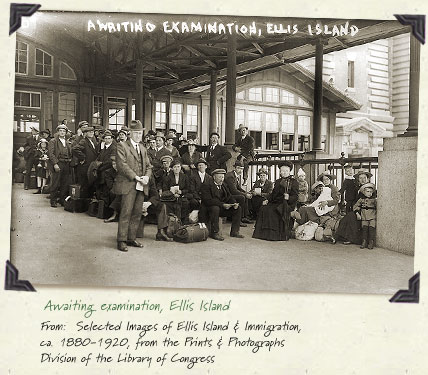
Describe all eight stops in your letter.
Then tell about your journey from Ellis Island in New York to Waterloo. How did you travel? What did you see? Who were you with?
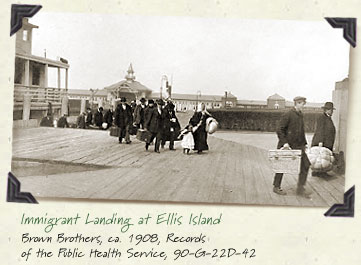

Choose one of the characters in the picture above.
For this person create a list of questions about them starting with the following. Then answer the questions.
Write a letter from this person back to his or her family in the home country telling about the trip to Waterloo, Iowa in 1908. Include information about the trip including some of the following topics and others that you identify:
 Clothing
Clothing
Read the stories of four men who came to Waterloo to find work.
Clifford Smith interview
Nicholas Sulentic’s story
Henry Nauman’s story
George P. Beck’s story
How were these men alike and how were they different from one another?
On a 3 X 5 card, draw a picture of each of these four people.
Then draw a picture representing or symbolizing the kind of work each started in Waterloo.
Place your pictures on a timeline that illustrates the sequence in which they lived and worked in Waterloo. Add to your timeline important dates found in this material concerning each person.

Immigration and emigration are the foundation of Iowa’s development.
After 1890, factory jobs began to attract immigrants to Iowa. Initial labor demands had been filled by local farmers and transient laborers.
 By 1920 the city of Waterloo, Iowa had attracted immigrants from twenty nations, and by 1925, 12% of the city’s population had been born in another country.
By 1920 the city of Waterloo, Iowa had attracted immigrants from twenty nations, and by 1925, 12% of the city’s population had been born in another country.
Tradition and skills drew immigrant groups to different trades: many Italians worked at the railroad shops; many Danes, Germans, and Irish were employed by meat-packing and farm equipment manufacturers; many Greeks and Mexicans worked in construction and paving; many Croatians and Bulgarians went to machine shops and foundries.
New arrivals lived in neighborhoods close to factories and streetcar lines. These neighborhoods became a blend of languages, traditions, ethnic dress and customs, and exotic foods. Immigrants’ skills, so important to the success of Waterloo industries, tied these newcomers to each other and to the community.
Read and listen to the stories of six immigrants who came to Waterloo. As you listen to their stories and experiences think about the key questions:
Then build a graphic organizer to compare and contrast their experiences.
Click on the voices and pretend that you are hearing these voices on local streets earlier in the century, reflecting the many cultures that have influenced this area.

In 1890 Maren Olesen came through Ellis Island on her way to Waterloo.
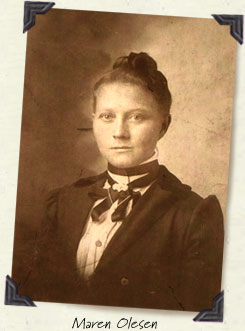 At age 17, Maren J. Christensen left her home and family behind in Denmark and set sail for the United States. Arriving at Ellis Island in 1890, she knew that other Danish immigrants had settled in Waterloo, so she boarded a train bound for Waterloo after a brief stop in Hoboken, New Jersey.
At age 17, Maren J. Christensen left her home and family behind in Denmark and set sail for the United States. Arriving at Ellis Island in 1890, she knew that other Danish immigrants had settled in Waterloo, so she boarded a train bound for Waterloo after a brief stop in Hoboken, New Jersey.
Maren did not speak English, and when she arrived in Waterloo on a below-zero night in February, she was stranded at the station with very little money and no way to communicate with the stationmaster. Although he could not understand her, he suspected that she was speaking Danish. At dawn, the stationmaster ran out to intercept Mr. Jensen, the milkman, as he passed by on his daily route. Mr. Jensen came into the station and spoke to Maren in Danish. She was so relieved she broke into tears. Mr. Jensen invited her to his home and she lived with the family for nearly a year as she learned to speak English and settled into the community.
In 1901, Maren married fellow Danish immigrant, Jens Olesen. They had two children, J. Peter Olesen and Katrine Olesen-Schumann. Jens Olesen and his son, J. Peter Olesen founded Jens Olesen & Sons Construction Company in 1921.
Both Maren and Jens Olesen are buried in Elmwood Cemetery in Waterloo, Iowa.
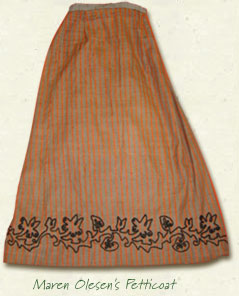
This wool petticoat was worn by Maren on her sea voyage from Denmark to the United States when she was 17 years old. The skirt was made from the wool of sheep raised by her family. The wool was carded, dyed, and woven into fabric by Maren’s mother who made the petticoat to keep Maren warm during her long sea voyage.
The petticoat has been handed down in the family over the years and was donated to the Grout Museum by Maren’s grandchildren, Roger Olesen, Waterloo; Joan Schumann-Broshar, Scottsdale, Arizona;, and Donna Schumann-Walker, Clear Lake, Iowa.
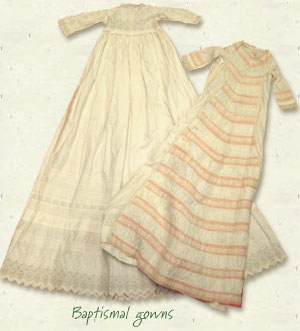
Baptismal gowns were often handed down through families as well. When Maren emigrated from Denmark in 1890, most Danes were members of the Lutheran Church. Unlike the United States where we don’t have a state religion, the Lutheran Church was the state church of Denmark. Maren Olesen would have had her children baptized in gowns like these—both the boys and the girls!
Using the world map trace Maren’s route to the United States from Denmark in 1890.
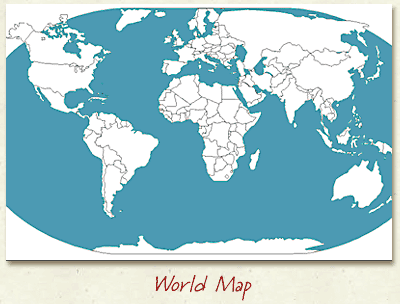
Identify the locations in the United States mentioned in the information about Maren. (Ellis Island, Hoboken, New Jersey, Waterloo, Iowa)
Using the map of the United States, draw Maren’s route to Iowa.
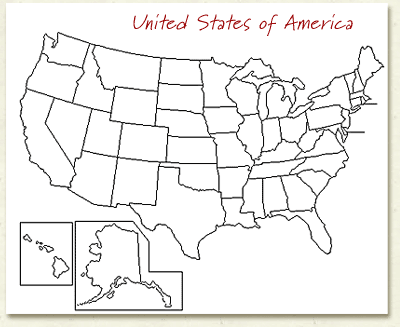

It is November of 1910. You and your nine-year-old younger brother have just landed at Ellis Island.
You are progressing through the eight stops in Ellis Island that all immigrants must follow to be admitted into the United States. You are both eager to join the rest of your family in Waterloo, Iowa.
You leave your trunk in the baggage room as required.
When you go back to retrieve your trunk, it is nowhere to be found. It has simply disappeared.
In 1909, Congress passed a law that immigrants had to have at least $20 with them. After you move through the money exchange you and your brother have $24.50 between you.
Fortunately you already have your train tickets from New York to Waterloo. But you need to buy a new trunk and enough clothes to get you to Iowa. You also need money for food.

The first Americans came from Asia thousands of years ago. Later people from countries of Europe and Africa and other parts of the world came to make the United States their home. Today America is home to people from all over the world.
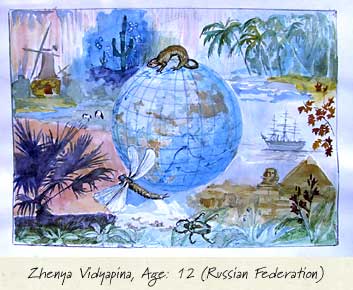
Interview your family members to find out what countries and continents your ancestors came from. Asia? Europe? Africa? South America? Australia? North America?
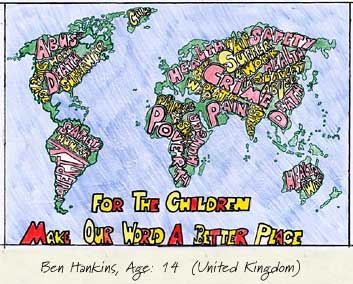
Choose one country or continent to represent you.
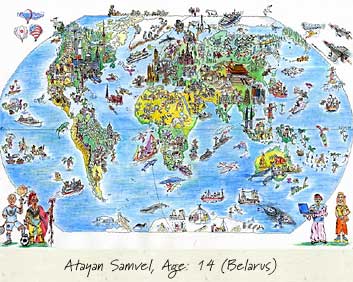
Go to the Online World Atlas and download a map of your country or continent.
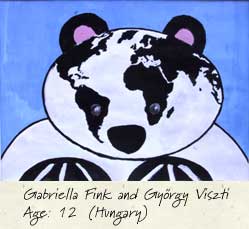
Then make a map picture that represents you. For creative ideas, explore the examples on this page created by other children around the world.
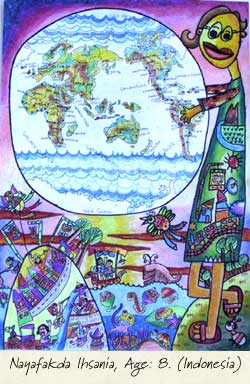
Credits:
From the Barbara Petchenik Children's Map Competition and the
Maps, Data and Government Information Centre at Carleton University Library. Used with permission from the International Cartographic Association.

Talking to people who remember events of long ago is a good way to learn about the past. In every community live people with valuable stories to share about their lives and their experiences. You can learn about your town by interviewing people who have recently immigrated to your community.
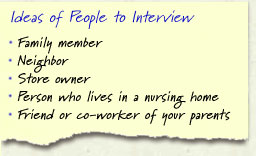
Select and research a topic. The best interviews are those which select specific topics to pursue in depth. You don't get a good answer if you ask someone to "tell me about the old days". Focus your interview on a specific topic. In this case, the topic is immigration.
If you don’t know of someone in your community to interview, your teacher can help you find a person.
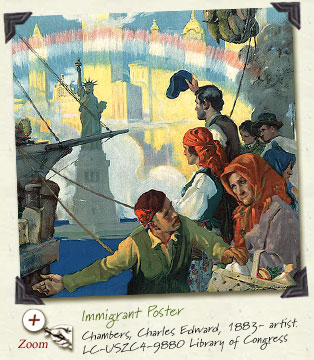
Whenever you interview someone, make sure you have their permission ahead of time to talk to them about their lives and to quote them. If you are planning to tape the interview, be sure to get permission for that as well.
Asking the right questions is the key to a good interview. The best questions are those that are specific. Try to avoid questions that can be answered with a “yes” or a “no.” Because you have studied the topic of immigration, your questions will be focused and clear. Here are some examples to get you started:
View an example of an Interview Summary.
As soon as possible, write up a summary of the major points of the interview. If you taped your interview, use the tape and your list of questions as a guide in writing your summary. Be sure to write about the most important points the person talked about.

Copyright © 2022 CampSilos | All Rights Reserved
National Standards | Silos & Smokestacks | Credits | Awards
Crafted by IFC Studios, a midwest Branding Agency.